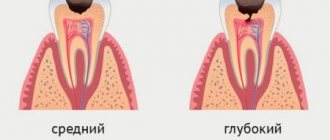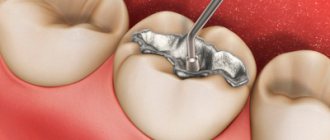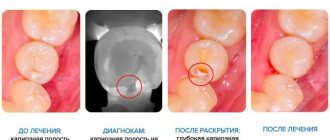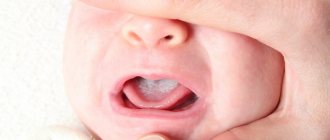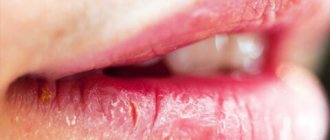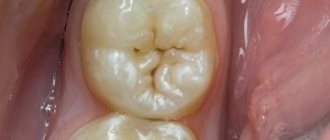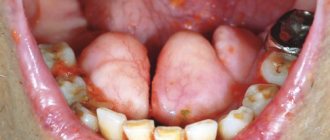Secondary caries is a new pathological process that occurs in the tissues of a tooth that has previously been subjected to dental treatment. Often, it appears due to insufficient antiseptic treatment of the carious cavity or poor-quality filling, but there may be other reasons, which we will discuss below.
Dental caries under a filling is characterized by a long asymptomatic course. The first symptoms may appear 2-3 years after the filling is installed: discoloration of the enamel and increased sensitivity of the tooth. In severe cases, pulpitis can develop, which can lead to serious consequences, including tooth loss and osteomyelitis of the jaw bone.
Causes of caries under fillings
As a rule, secondary caries is the result of a whole complex of different factors. Only a dentist can name the exact cause, based on medical history and examination of the unfilled tooth - after he sees what caries looks like under the filling and determines what factors could cause it.
Of particular importance in the formation of secondary pathology is the individual susceptibility of tooth tissue to caries, the composition of the filling material, as well as compliance with oral hygiene.
The main causes of caries under fillings:
- Application of high shrinkage fillings. Over time, such fillings reduce their volume in the carious cavity, which provokes detachment of the filling material from the edges of the hard tissues of the tooth. Bacteria penetrate into the spaces unfilled with a filling, provoking a new stage of caries development. Sometimes, caries damage can be seen with the naked eye along the edges of the filling, especially on the front teeth;
- Poor-quality cleaning of a carious cavity is a direct mistake by the doctor when filling: the affected tissue remains inside, in which bacteria are concentrated, continuing tooth destruction;
- Poor processing of the filling - rough grinding and polishing contribute to increased adhesion, which leads to accelerated plaque formation on the surface of hard tooth tissues, as well as the formation of chips of the filling material and microcracks.
Caries is a systemic disease that can occur not only due to the above reasons, but also due to general factors. For example, in regions of Russia with low fluoride content in the soil, more than 97% of the population (all age groups) suffer from primary and secondary caries. Also, the development of caries under a filling can be triggered by the patient’s refusal of immunomodulatory therapy during the treatment of concomitant diseases.
Primary, secondary, tertiary prevention of caries
Primary, secondary and tertiary prevention of caries refers to a number of measures aimed at preventing and correcting the consequences of the disease at various stages. This classification is also relevant in the case of dental caries under a filling.
| Prevention of caries | Description |
| Primary prevention of caries | Preventing caries before the disease spreads. This includes taking vitamins, correcting nutrition and maintaining a healthy lifestyle (all together this is endogenous prevention). Another subtype of primary prevention is exogenous. This includes professional hygiene with a doctor, the use of products to strengthen enamel and teeth, and undergoing fluoridation and fissure sealing procedures. |
| Secondary prevention of caries | Primary and secondary prevention of caries differ in that in the second case we are dealing with a formed carious cavity. Secondary prevention of dental caries is a complex of therapeutic and endodontic manipulations aimed at eliminating caries and preserving the tooth. |
| Tertiary caries prevention | Restoring a tooth that has been irreversibly damaged by caries using prosthetics or implantation. |
Key differences between secondary caries and recurrent caries
Unlike secondary caries, recurrent caries occurs only at the site of treatment already performed. If lesions appear on the same tooth, but nearby, this is repeated caries. It is almost impossible to find out the cause of the development of recurrent or repeated caries. Only a doctor, based on examination data, can suggest why caries appeared under the fillings.
When diagnosing secondary and recurrent caries, the doctor must remember that both types can develop in combination due to a combination of various factors.
Risk factors
Factors of wear resistance of the filling:
- exposure to low and high temperatures - simultaneous intake of cold and hot food;
- eating hard, tough foods;
- bite defects, improper closing of the jaws - leads to excessive friction of the teeth;
- pathological abrasion of enamel, bruxism;
- violation of hygiene rules.
If you skimp on brushing your teeth after eating, be aware that food debris accumulates in the interdental spaces and in the cusps of your chewing teeth. A persistent bacterial plaque is formed, which will lead to secondary caries.
Symptoms of caries under a filling
In the vast majority of cases, secondary caries is asymptomatic. The first signs, with rapid development, may appear only 3-6 months after the filling is installed. If symptoms appear 2-4 weeks after filling, this is recurrent caries. It occurs due to improper treatment and can pose a serious threat to the tooth. To eliminate it, it is necessary to replace the old filling with repeated cleaning and disinfection of the carious cavity.
Classic symptoms of caries under a filling include:
Darkening of the enamel near the edge of the installed filling - pigmentation can be located either at one edge or along the entire rim of the filling;- The causative tooth acquires a gray tint, through the enamel you can see what caries looks like under the filling - it will have a dark tint;
- Chips of the filling and tooth enamel appear, microcracks form (not always);
- The mobility of the filling increases. With prolonged development of caries, it may fall out;
- There is an unpleasant odor from the mouth, caused by the proliferation of bacteria in the formed microcracks;
- Increased sensitivity of teeth to cold, hot, sour and sweet;
- Aching pain appears, which intensifies during the process of biting;
- Acute tooth damage by secondary caries develops, accompanied by pain, swelling and bleeding.
Why does recurrent caries occur?
One of the main reasons for the development of this form of caries is errors or inaccuracies that were made by the dentist at the stages of treating the carious cavity and installing a filling. In particular, such errors include poor-quality tooth preparation using a drill, incomplete removal of affected tissue, filling without taking into account the shrinkage of the material. Along with the listed reasons, the following factors can provoke a recurrence of caries:
- eating foods that are too hard and can damage teeth, as well as foods high in acid;
- sudden changes in temperature;
- habit of grinding teeth;
- poor oral hygiene.
Consequences of secondary caries
The lack of timely diagnosis and proper treatment leads to the development of complications in the form of acute or chronic tooth pulpitis with aching pain and all the ensuing consequences. At this stage, replacing the old filling with a new one, while simultaneously cleaning the carious cavity, will not help - preliminary treatment of pulpitis is necessary.
Delaying the treatment of pulpitis under a filling leads to partial or complete destruction of the hard tissues of the tooth. It is accompanied by the development of infection affecting the periodontal tissues with subsequent progression to periodontitis. In particularly severe cases, periodontitis affects the jaw bone - this can result in osteomyelitis of the jaw bone.
CONSEQUENCES OF UNTIME TREATMENT
If you suspect the presence of a carious process under a filling, you should immediately make an appointment with a dentist. To register with West Dental, you can go to our website and fill out the feedback form or call the numbers provided. Failure to eliminate the pathology in a timely manner can be dangerous due to:
- Damage to the jaw bone. Inflammation can affect all bone structures.
- Destruction of the tooth root with a root canal. If the roots are damaged, the only answer to solve the problem is to extract the unit.
- Transfer of the pathological process to neighboring units that were completely healthy.
- Large area of destruction of the crown and root parts of the tooth.
A great danger in the secondary process is inflammatory diseases of the pulp chamber and its further death. This can occur due to the use of chemical solutions during drug treatment and traumatization with burs.
Methods for diagnosing and treating caries under fillings
It is quite difficult to determine the presence of secondary caries in the initial stages, due to the absence of symptomatic and visual manifestations. The disease is diagnosed during a follow-up appointment using diagnostic equipment (hardware diagnostics).
Diagnostics includes two stages:
- Anamnesis and initial examination of the causative tooth in order to detect visible structural changes in hard tissues;
- Hardware diagnostics (physiography) is aimed at detecting hidden changes in the structure of dental tissues.
If a pathology is detected, treatment is prescribed taking into account the individual characteristics of the patient.
DIAGNOSTICS
At a consultation, when applying, the dentist conducts a visual and instrumental examination of the teeth and oral cavity. Also, for a more accurate assessment of the condition of all structures and differential diagnosis of pathologies, an RG image may be needed.
At the branches of the West Dental clinic in Vsevolozhsk and Yanino, you can perform targeted X-rays, orthopantomograms and CBCT scans. The radiation dose when taking pictures is very small, which makes the procedure completely harmless to the health of adults and children. X-ray examination allows you to quickly diagnose secondary caries.
Features of treatment of secondary caries
The use of one or another treatment regimen for secondary caries directly depends on the location of the lesion, its depth and the condition of the causative tooth. Treatment may include two options for developing the situation:
- Re-filling or replacing part of the filling in the affected area is performed only after treating the tooth and eliminating the carious lesion. In some cases, it may be necessary to remove the nerve and fill the canals.
- Surgical tooth extraction is used in extreme cases when the damage is too large and the doctor cannot save the affected tooth.
Prevention
For daily care, we recommend using certified toothpastes with fluoride and calcium and rinsing your mouth with antiseptic liquids (Glister, Splat, Lacalut).
Don’t forget to get examined by a dentist once every six months in order to detect a relapse in time. A method of preventive filling will also not hurt - covering the fissures with a sealant or liquid composite.
Remember that the doctor is obliged to give you a guarantee for the filling. During the warranty period (6-12 months), you have the right to undergo free re-treatment in case of caries recurrence.
Do you have a toothache after endodontic treatment? Find out what pain signals after root canal filling.
Methods for preventing caries under a filling
High-quality prevention of secondary caries involves the elimination of complications at the stage of initial installation of a filling - the doctor must ensure the correct method of caries treatment, antiseptic treatment of the hole for the filling and installation of the filling.
On the patient’s side, the most effective prevention of secondary caries under a filling is maintaining proper oral hygiene, as well as systematic examinations in a dental clinic: a month after the filling is installed and at least 2 times a year thereafter.
How does tooth decay occur due to caries?
In modern dentistry, caries is a slow process of destruction of hard tooth tissues that occurs under the influence of external and internal factors. The main cause of carious lesions is bacteria that live in the oral cavity and, by processing carbohydrates from food, produce acids. They are harmful to our teeth because they penetrate the structure of tooth enamel and dentin, causing damage.
The development of caries is promoted by:
- excess carbohydrates and sugars in food,
- poor brushing of teeth, which does not effectively remove plaque (accumulation of bacteria);
- Poor nutrition, which causes a lack of mineral compounds and other beneficial substances in the body.
At an early stage, caries looks like a light spot on the enamel. But it is difficult to notice, because there is no pain or discomfort. Therefore, most often, patients turn to the dentist when the carious process has destroyed a significant part of the tissue and a hole has formed in the tooth. Such caries is treated by preparing the tooth with a drill and installing a filling.
How is re-filling and inlay placement performed?
When re-filling, the dentist removes the old filling and thoroughly cleans the carious cavity from the remains of damaged and dead tissue. When the cavity is cleaned, the doctor treats it with an antiseptic with drugs that contain calcium. After antiseptic treatment, an insulating gasket is placed at the bottom of the cavity, on top of which a new filling material is placed.
In case of deep caries, a dental inlay can be installed under the filling to preserve the entire crown of the tooth. To do this, the doctor removes the affected areas of tissue, depulps the tooth, treats it with an adhesive composition and installs an inlay into the cavity, created according to the individual parameters of a particular patient. Treatment must be carried out with strict adherence to antiseptic and aseptic measures to avoid the development of secondary caries in the pulpless tooth.
How is relapse of caries treated?
At the first signs of recurrent caries, you should contact your dentist. The doctor will conduct a visual examination and do a visiography to get a complete picture of the pathological process. The choice of treatment method depends on the diagnostic results. If a relapse of the carious process is detected at an early stage and the treatment prognosis is favorable, the dentist performs a second filling. If irreversible processes have already begun in the dental tissues and the disease has entered a deep stage, it may be necessary to install a special inlay. If the tooth is destroyed to the root, the dentist may decide to install a crown.
How is tooth restoration performed using a crown?
The decision to restore a tooth is made by the dentist together with the patient in the case when a relapse of caries has damaged the dental nerve and almost completely destroyed the natural crown of the tooth.
Modern artificial crowns are made from high-quality materials that are similar in color and structure to natural teeth. Most often it is zirconium dioxide or metal ceramics. Treatment in this way is carried out in several stages:
- the diseased tooth is depulped, that is, the nerve is removed from it;
- a filling is applied to the damaged area;
- make an impression of the patient’s jaw to make a crown that exactly fits the parameters;
- the next stage is an intermediate visit to the dentist to try on the manufactured crown;
- grinding down the destroyed coronal part of the tooth and installing an artificial crown on it;
- in case of advanced caries, in addition to grinding the walls, it is necessary to install a special metal inlay, which will ensure a tight fit of the crown.
